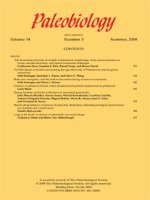The evolution of scutes in thyreophoran dinosaurs, based on Scutellosaurus, Scelidosaurus, Stegosaurus, and several ankylosaurs, began with small rounded or ovoid structures that typically had slight, anteroposteriorly oriented keels. These scutes were elaborated in two general and overlapping ways: they could flare laterally and asymmetrically beneath the keels that mark the anteroposterior axis, and they could be hypertrophied in their distal growth to produce plates, spikes, and other kinds of ornamentation. Stegosaurus plates and spikes are thus primarily hypertrophied keels of primitive thyreophoran scutes, sometimes with elaboration of dermal bone around their pustulate bases. Histologically, most thyreophoran scute tissues comprise secondary trabecular medullary bone that is sandwiched between layers of compact primary bone. Some scutes partly or mostly comprise anatomically metaplastic bone, that is, ossified fibrous tissue that shows incremental growth.
The “plumbing” of Stegosaurus plates was not apparently built to support a “radiator” system of internal blood vessels that communicated with the outside of the plates and coursed along their external surfaces to return heated or cooled blood to the body core. Possibly a purely external system supported this function but there is no independent evidence for it. On the other hand, many of the vascular features in stegosaurian plates and spikes reflect bautechnisches artifacts of growth and production of bone. Surface vascular features likely supported bone growth and remodeling, as well as the blood supply to a keratinous covering. When the gross and microstructural features of the plates and spikes are viewed in phylogenetic context, no clear pattern of thermoregulatory function emerges, though an accessory role cannot be eliminated in certain individual species. It seems more likely, as in other groups of dinosaurs, that the variation of dermal armor form in stegosaurs was primarily linked to species individuation and recognition, perhaps secondarily to inter- and intraspecific display, and rarely to facultative thermoregulation.





